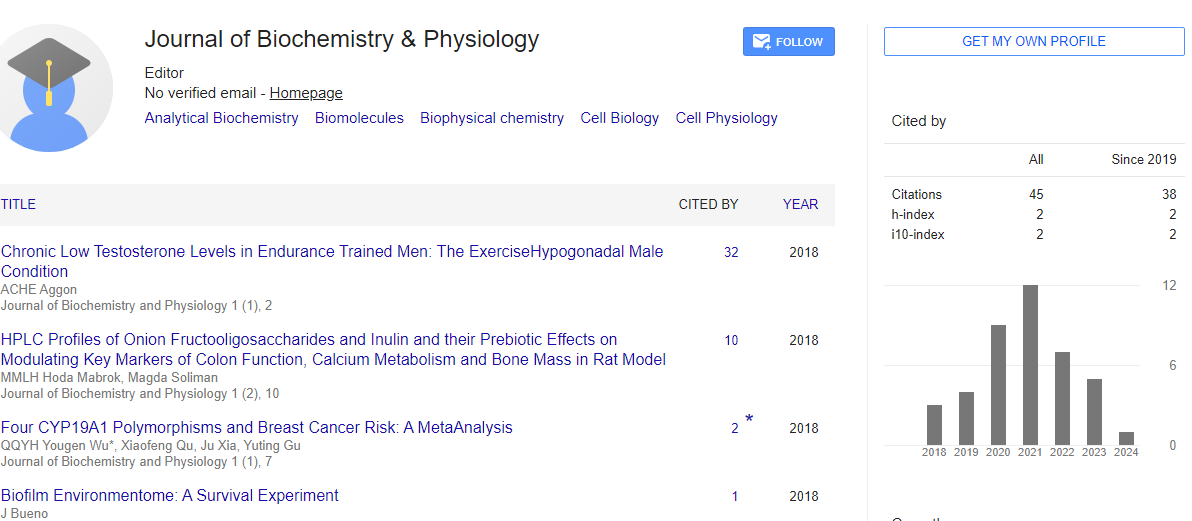Opinion Article, J Biochem Physiol Vol: 7 Issue: 3
Fluorescence-Based Techniques for Real-Time Monitoring of Enzyme Activity
Adam Thazhe*
1Department of Chemistry and Biochemistry, Mendel University in Brno, Czech Republic
*Corresponding Author: Adam Thazhe,
Department of Chemistry and Biochemistry,
Mendel University in Brno, Czech Republic
E-mail: Thaz@adamzhe.cz
Received date: 19 August, 2024, Manuscript No. JBPY-24-139479;
Editor assigned date: 21 August, 2024, PreQC No. JBPY-24-139479 (PQ);
Reviewed date: 04 September, 2024, QC No. JBPY-24-139479;
Revised date: 12 September, 2024, Manuscript No. JBPY-24-139479 (R);
Published date: 19 September, 2024, DOI: 10.4172/jbpy.1000161.
Citation: Thazhe A (2024) Fluorescence-Based Techniques for Real-Time Monitoring of Enzyme Activity. J Biochem Physiol 7:3.
Description
Enzymes are important in regulating biochemical processes, catalyzing reactions essential for life. Understanding enzyme activity in real time is crucial for advancing our knowledge of cellular functions, drug development and disease mechanisms. Fluorescencebased techniques offer powerful, sensitive and versatile tools for monitoring enzyme activity, providing high temporal and spatial resolution. Fluorescence-based techniques utilize the emission of light by fluorophores, which can be naturally occurring in substrates or products or introduced artificially. These techniques involve exciting fluorophores with a specific wavelength and detecting the emitted light at a different wavelength. Changes in fluorescence intensity, wavelength, or lifetime serve as indicators of enzyme activity, enabling real-time analysis.
Fluorogenic substrates are non-fluorescent molecules that become fluorescent upon enzymatic reaction. This method is widely used for detecting activities of enzymes like proteases, glycosidases and kinases. The substrate typically contains a fluorophore linked to a quenching group that is released upon enzymatic cleavage, resulting in an increase in fluorescence. Forster Resonance Energy Transfer (FRET) Assays: is a technique used to study molecular interactions and enzyme activities. It relies on energy transfer between two fluorophores (a donor and an acceptor) based on their proximity. Enzymatic reactions affecting the distance or orientation between the fluorophores result in changes in FRET efficiency.
Fluorescence anisotropy measures the rotational mobility of fluorophores. When excited with polarized light, fluorophores emit light that retains polarization if they remain relatively immobile. Enzymatic reactions that change the size or binding state of the fluorescent molecule affect its rotational diffusion, detected as changes in fluorescence anisotropy. Fluorescent biosensors are designed to report specific enzymatic activities through conformational changes or environmental sensitivity. These biosensors incorporate fluorophores whose fluorescence properties change in response to the enzymatic activity.
Applications of fluorescence-based techniques
Real-time monitoring of enzyme activity is critical in drug discovery, particularly for screening enzyme inhibitors or activators. Fluorescence-based assays facilitate high-throughput screening, allowing rapid identification of potential therapeutic compounds that affect enzyme function. Abnormal enzyme activities are often associated with diseases. Fluorescence-based techniques can detect changes in enzyme activity, aiding in the diagnosis and monitoring of diseases. Fluorescence-based techniques are instrumental in studying enzyme mechanisms, kinetics and regulation. They offer the sensitivity and specificity required to investigate dynamic enzyme behaviors within complex biological systems.
These techniques can detect minute changes in enzyme activity, allowing for the study of low-abundance enzymes and subtle kinetic variations. The use of specific fluorogenic substrates or biosensors enables the selective measurement of target enzyme activities in complex mixtures or live cells. Real-time monitoring allows for the observation of enzyme activity dynamics over time and fluorescence imaging techniques provide spatial resolution to localize activities within cells or tissues.
Conclusion
Fluorescence-based techniques are essential for real-time monitoring of enzyme activity, offering detailed insights into biochemical processes. From fluorogenic substrates and FRET assays to fluorescence anisotropy and biosensors, these methods provide the sensitivity, specificity and resolution needed for diverse applications in drug discovery, disease diagnosis and basic research. As fluorescence technology continues to advance, it will further enhance our ability to study and manipulate enzyme activities, contributing to the development of new therapies and a deeper understanding of cellular biochemistry.
 Spanish
Spanish  Chinese
Chinese  Russian
Russian  German
German  French
French  Japanese
Japanese  Portuguese
Portuguese  Hindi
Hindi 